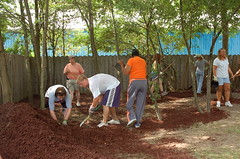The map said Bilboa-final resting point before an early a.m. departure tomorrow (August 3rd)--was only 175 kilometers or so from Pamplona. If one travels in a more or less straight line and observed all speed limits, the journey should take no more than two hours. Traveling a far more circuitous route, we managed to turn the trip into an eleven hour adventure.
Rather than head west toward Bilboa, we elected to travel east, tracing the Camino de Santiago to its source: St. Jean Pied de Port in southern France. This required travel along a two lane highway that seesawed back and forth across the Pyrenees in a way that tested how tightly I could grip the  steering wheel without breaking it (or my hand)! As we climbed up (and up and up and up) this mountain trail, Camino-travelers became more frequent. As we twisted and turned downward along roads where there was little margin for error (lest a long drop ensure), some travelers still early in their adventure were struggling up the mountain slope. I wondered what that might bode for their Camino success. [BTW...a really great website for information about the Camino can be found at: http://www.caminodesantiago.me.uk/].
steering wheel without breaking it (or my hand)! As we climbed up (and up and up and up) this mountain trail, Camino-travelers became more frequent. As we twisted and turned downward along roads where there was little margin for error (lest a long drop ensure), some travelers still early in their adventure were struggling up the mountain slope. I wondered what that might bode for their Camino success. [BTW...a really great website for information about the Camino can be found at: http://www.caminodesantiago.me.uk/].
St. Jean Pied de Port proved far too busy for our taste. Passing through, we navigated north to a small town where a pleasant noon day meal was consumed. From there it was back into the Pyrenees--back and forth up to  the summit at Ispiguey (think “Miss Piggie”). While I took pictures throughout the mountains, I doubt they do justice to the grandeur evident when standing along the side of the road, gazing at God’s handiwork across the many miles visible. No one the folks who populated these mountains and trails centuries ago found it easy to erect churches and monasteries to celebrate gifts with which they were confronted every time they rose and looked out the window.
the summit at Ispiguey (think “Miss Piggie”). While I took pictures throughout the mountains, I doubt they do justice to the grandeur evident when standing along the side of the road, gazing at God’s handiwork across the many miles visible. No one the folks who populated these mountains and trails centuries ago found it easy to erect churches and monasteries to celebrate gifts with which they were confronted every time they rose and looked out the window.
Traveling northward through the Pyrenees we finally reach Irun, on the north Atlantic coast. This gave us one more chance to spend time along the coast so we jumped on two lane highways that---you guessed it---seesawed up and down the coastline. Quite frankly, today’s travel made me long for a quick trip up US 30 from Fort Wayne to Valparaiso. I may take Monday off and do so!

I still find Spain fascinating; southern France had some charm as well. Given the intensity with which I usually work and the breadth of the tasks to which I am always committed, this journey away afforded opportunities to refresh and nourish my soul. Remote places (curves and all) were especially helpful. When I can strip away the “noisiness” of daily living and hang out in the natural, unblemished world, the spirit that has dampened within me can fed by the Spirit that surrounds me. Our Spanish journey reminded me how important those opportunities are to me and gave me a good swift kick in the ---- toward making a better effort at doing so.
For those of you who have traveled with us as we flitted from town to town, I thank you for your time, thoughts, and prayers. We had several chances to stroll along Spanish parkways and river walks where it seemed as if the entire community had turned out looking for connections with family and neighbors. Far too often our rugged American individualism leaves us thinking that we can go it alone and our experience are personal only. This blog was a deliberate attempt to build community; I offered up travel photos, personal tidbits, and some serious reflection hoping to start a conversation trend. If you’ve heard that call, you have my special thanks.
And, as the Spanish folks say “Buenvenidos.”
Day Eleven photos can be found at:
www.flickr.com/photos/42254846@N00/sets/72157601176659920/






















